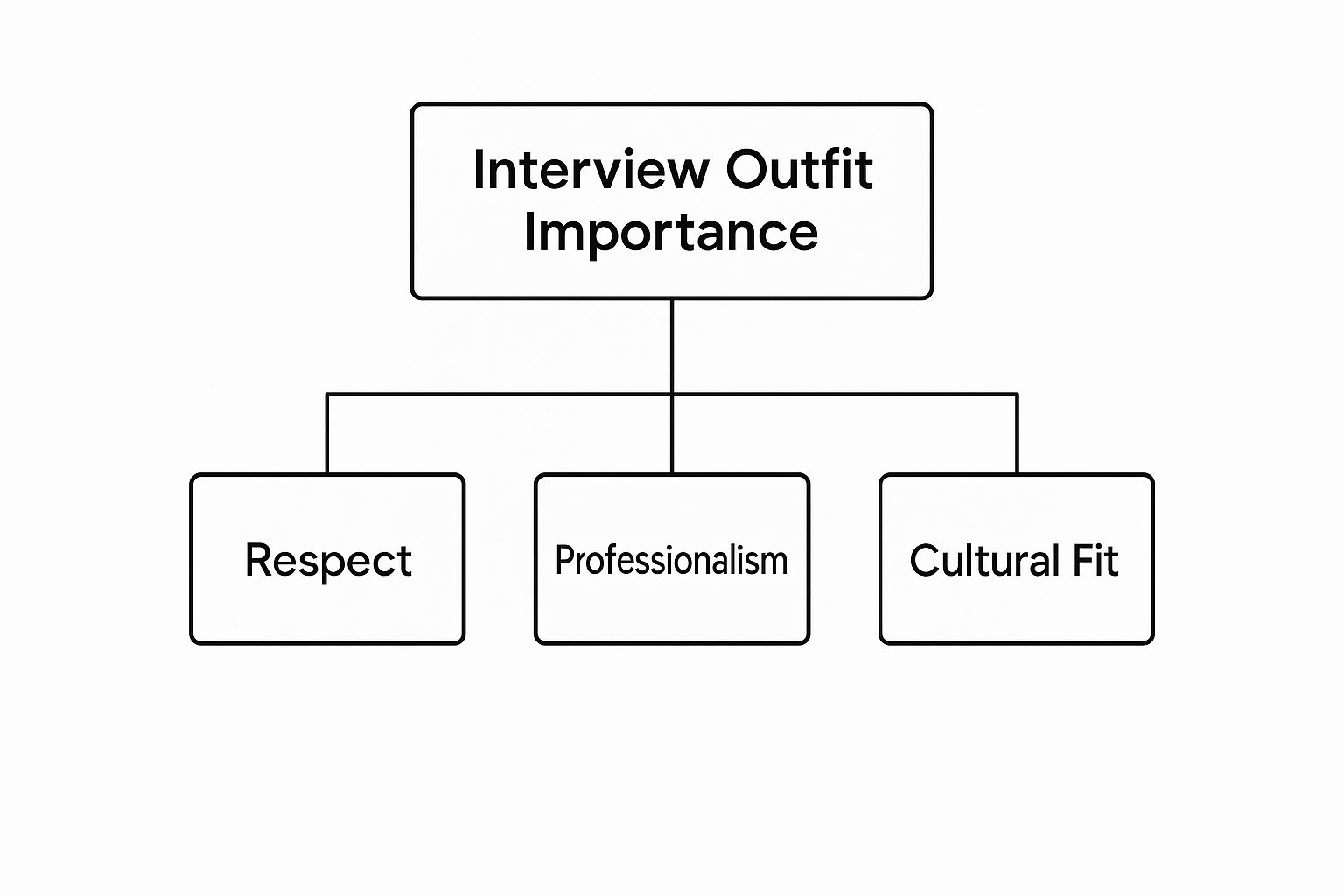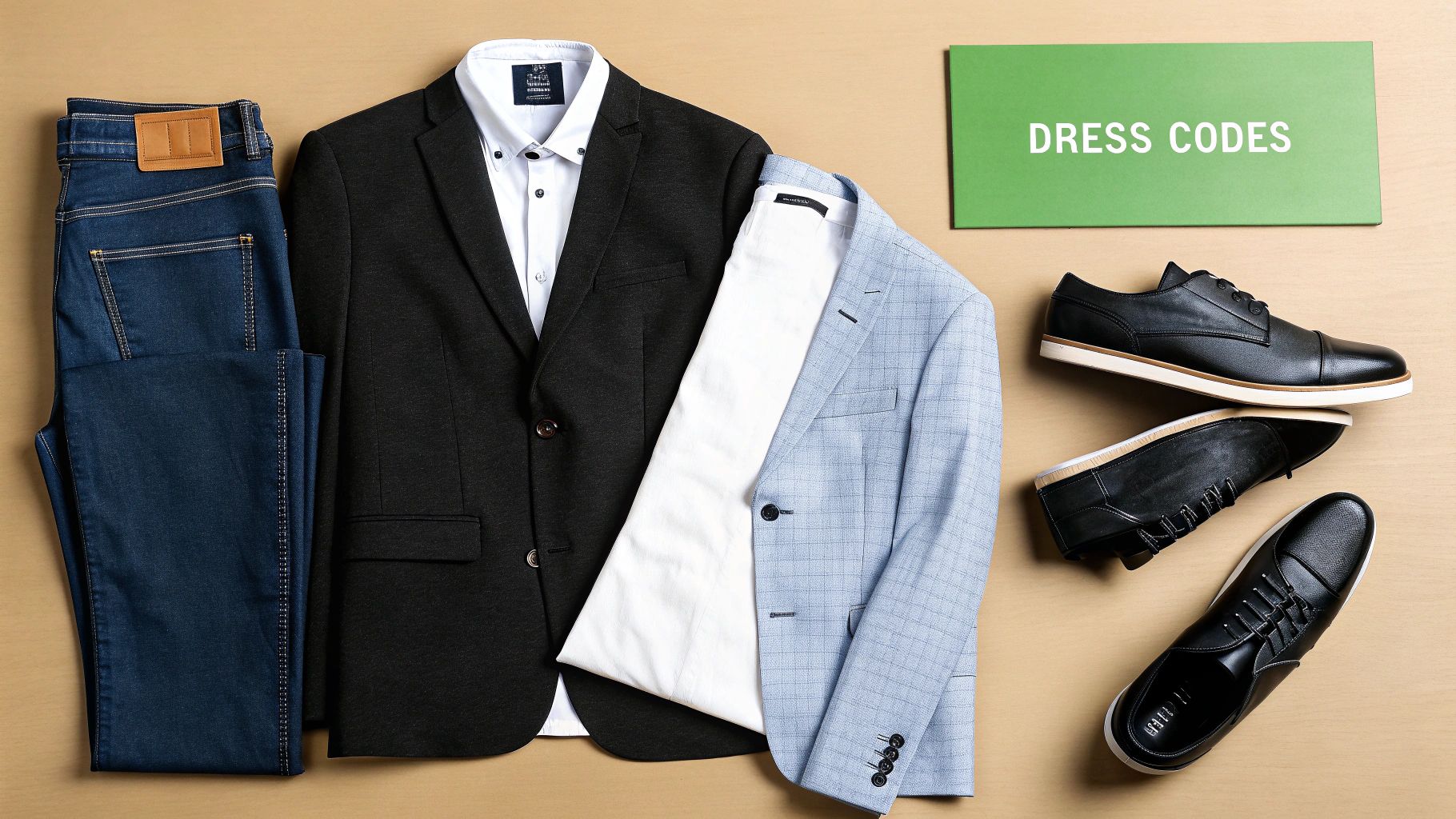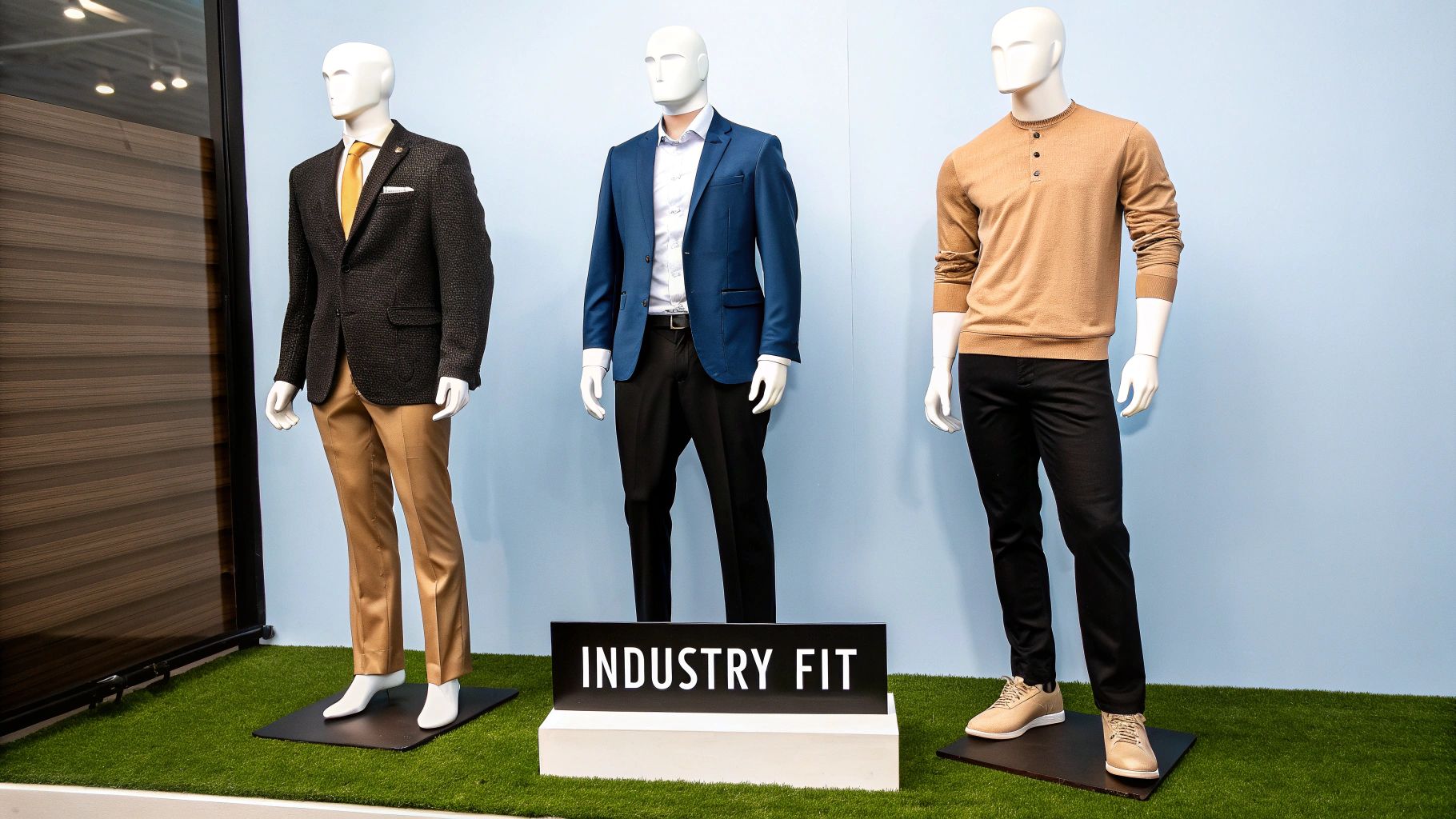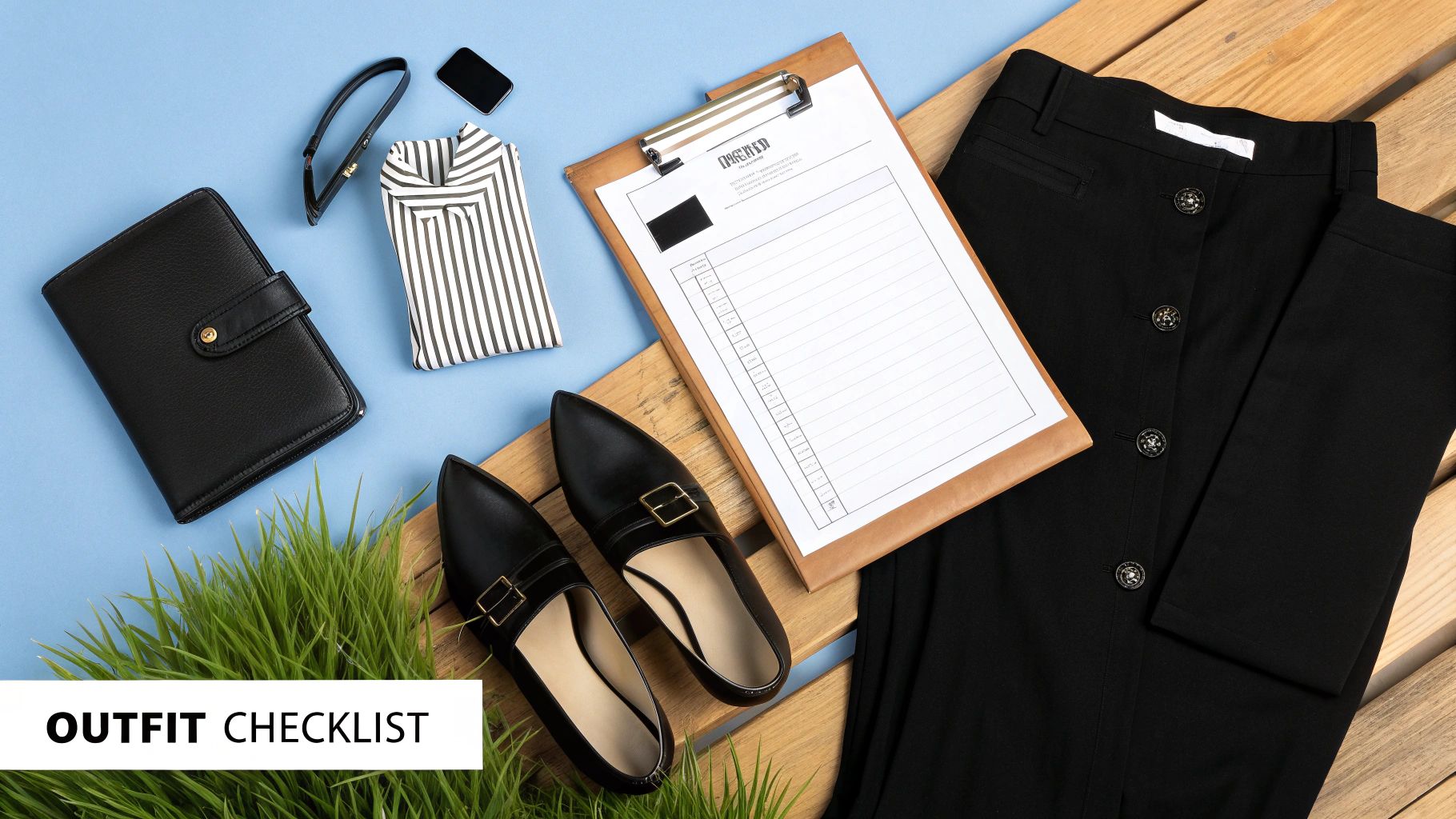What Should You Wear to Interview? Expert Tips for UK Success
- Ricky Cohen
- Oct 13
- 12 min read
Deciding what to wear for an interview feels trickier than ever these days. The once-universal rule of 'just wear a suit' no longer applies, leaving many people guessing.
There's a much simpler, more effective guideline to follow: dress one level smarter than the company’s daily dress code. This simple trick shows you respect the opportunity and the interviewer's time, without making you look out of place. It proves you've done your homework on their culture.
Why Your Interview Outfit Still Matters
Figuring out the right interview outfit can feel like cracking a code, especially as UK workplaces have become much more relaxed. With the rise of remote working and a bigger emphasis on company culture, the old, rigid rules feel completely outdated. Now, it's less about following a specific formula and more about understanding the 'why' behind your clothing choices.
This change isn't just a feeling; the numbers back it up. A 2023 report highlighted an 80% drop in UK companies enforcing a strict, formal dress code. Relaxed and smart-casual is the new norm.
Think of your outfit as the first thing you say to the hiring manager, long before you even shake hands. It’s a powerful non-verbal cue that instantly communicates a few key things:
Respect: Putting thought into your appearance shows you’re taking the interview seriously and value the opportunity.
Professionalism: A tidy, well-chosen outfit signals that you understand workplace standards and are serious about your career.
Cultural Fit: Your choice of clothing can show the interviewer you've researched the company and can genuinely picture yourself on their team.
This infographic breaks down exactly why your outfit choice is such a crucial piece of the puzzle.

At the end of the day, your clothes should support your expertise, not distract from it. Your outfit is part of the professional story you're telling, and getting it right allows your skills and experience to take centre stage. As any good recruitment consultant will tell you, matching a candidate to the right company culture is vital, and your attire is one of the first things they assess.
What to Wear: Cracking the Modern Interview Dress Code

Trying to figure out what to wear for an interview can feel like you’re trying to crack a secret code. But it doesn't have to be that complicated. Let's break down the three main dress codes you’ll come across: Business Formal, Business Casual, and Smart Casual.
Think of them less as rigid rules and more as a spectrum of professionalism. Getting it right shows the interviewer you’ve done your homework and you understand the company culture. After all, the expectations for a corporate finance role are worlds away from those for a site-based position found through a construction recruitment agency, where being practical and grounded is far more important.
Business Formal: The Classic Suit and Tie
This is the top tier of professional wear, reserved for the most traditional and corporate environments. We’re talking about a classic, well-fitting suit in a conservative colour—think charcoal grey, navy blue, or black.
For men, that means a full suit, a crisp formal shirt, a silk tie, and polished leather shoes. For women, it’s a tailored trouser or skirt suit, or a conservative dress paired with a smart blazer. The magic here is in the details. A perfectly tailored suit speaks volumes about your attention to detail before you’ve even said a word.
Business Casual: The New Standard
Business Casual has become the go-to for most interviews across the UK today. It hits that sweet spot between looking professional and feeling approachable. You're essentially ditching the full matching suit for smart, coordinated separates.
For Men: A pair of smart trousers or chinos with a collared shirt is your foundation. You can easily layer this with a blazer, a sports coat, or a V-neck jumper for a bit more polish.
For Women: Think tailored trousers or a knee-length skirt paired with a smart blouse. A simple, well-cut dress or a smart knit top are also great options. A blazer isn't always essential, but it’s a quick way to sharpen up any outfit.
The real aim of Business Casual is to look sharp and assembled without looking stiff. It tells the interviewer you’re a professional who can also be a relatable team member.
Smart Casual: Polished But Relaxed
This is the one that trips most people up. Smart Casual is the most relaxed of the three, but it’s a world away from your weekend slob-out clothes. The name of the game is to look neat, tidy, and effortlessly stylish.
For an interview, you might be able to get away with a pair of smart, dark-wash jeans—but only if they are pristine, with no rips or fading. Pair them with a quality top and a blazer to elevate the look instantly. For women, a stylish dress with smart flats or ankle boots can be perfect. The trick is to mix casual staples with more formal, high-quality pieces to create a look that feels modern and put-together.
Interview Dress Code At-a-Glance
To make things even clearer, here’s a quick reference table to help you visualise the key differences and know exactly when to wear what.
Remember, this table is a guide. The best approach is always to research the specific company’s culture. When in doubt, it’s always better to be slightly overdressed than underdressed.
Matching Your Outfit to the Industry Culture

Figuring out what to wear for an interview isn't just about picking nice clothes; it’s about reading the room before you’ve even entered it. A sharp suit that would nail an interview at a law firm could make you look completely out of touch at a tech start-up. Think of your outfit as your first move – it shows you’ve done your homework on the company culture.
Get this right, and you're already showing the interviewer you’re a good fit before you even sit down. It proves you understand their world and can picture yourself being part of the team.
Corporate Environments: Finance, Law, and Property
When you’re interviewing in traditional sectors like finance, law, or high-end property, Business Formal is almost always the unwritten rule. This is the classic uniform of established professionalism, and it signals that you’re serious, detail-oriented, and respect the company's long-standing traditions.
For men: Stick to a well-fitted suit in navy or charcoal grey. Pair it with a crisp white or light blue shirt, a conservative silk tie, and polished leather shoes.
For women: A tailored trouser or skirt suit is the way to go. Wear it with a simple shell top or blouse and smart court shoes.
The aim here is to project an image of authority and competence. These industries are built on tradition, and your clothing should reflect that you get it.
Creative and Tech Sectors
Switch gears completely for creative fields and the tech industry. These places prize innovation and personality far more than old-school formality. Here, Business Casual or even Smart Casual is your best bet. Turning up in a stiff corporate suit can accidentally send the message that you won’t fit into their collaborative, relaxed culture.
Your outfit should still be professional, but it needs to let a bit of your individuality shine through. Think smart chinos, a quality knit, a stylish blouse, or even a pair of dark, well-fitting jeans teamed with a blazer. It’s about looking capable and put-together, not corporate.
The key takeaway for any interview is that your outfit speaks for you. It should communicate that you're professional, respectful, and a fantastic cultural fit for the specific company you're hoping to join.
Public Sector and Education
Jobs in the public sector, like government roles or teaching, tend to land somewhere in the middle of the spectrum. The safest and most effective choice is usually a conservative take on Business Casual. You want to look trustworthy and professional, but also approachable and grounded.
This means steering clear of anything too flashy or, on the flip side, overly casual. Smart trousers, a knee-length skirt with a nice blouse, or a collared shirt with a tidy jumper are all solid options. The goal is to look organised and reliable.
Recent data reveals a huge shift across UK industries. Of all job adverts that mention a dress code, an incredible 79.9% now promote relaxed or casual attire. But this isn't a one-size-fits-all trend. Retail remains one of the most formal sectors, while industries like IT (92.3%) and engineering (96.4%) have almost completely moved to a casual approach. You can discover more insights about these workplace trends and see how they might influence what you should wear to your next interview.
Dressing for a Virtual Interview
When your interview is on a screen, the game changes slightly. You’re not just presenting yourself; you’re also producing a small video call. Everything from your background and lighting to what you’re wearing on your top half shapes that crucial first impression.
Cameras can be funny with certain fabrics and patterns. Busy prints or overly bright colours can look jarring and sometimes create a strange, shimmering effect on screen. Even pinstripes can seem to flicker and dance, which is the last thing you want to distract an interviewer. Your safest bet is to go with solid, muted colours – think classic blues, greys, or even soft earth tones.
In a video call, your top half is the main event. The simple rule is to dress from the waist up exactly as you would for a face-to-face meeting. A smart blouse, a well-ironed collared shirt, or a simple blazer will make you look polished and ready for business.
Check Your Tech and Background
Don't forget that your surroundings are part of your presentation. A messy, cluttered background sends the wrong message. Find a spot with a neutral wall or a tidy bookshelf behind you to keep the focus on you.
Always do a quick test run before the interview starts. Fire up your camera to check the angle and lighting. You want to avoid looking like you’re sitting in the dark or have strange shadows across your face. Natural light from a window in front of you is usually the most flattering.
Remember, a virtual interview demands just as much thought as a face-to-face meeting. Your digital first impression is crucial for showing the interviewer you are serious about the role.
This focus on professionalism still holds true, even as general workplace attire relaxes. UK attitudes have shifted, but candidates are always expected to show they've made an effort. Interestingly, a 2017 study found that 61% of UK workers would view a company with a strict dress code negatively, showing a clear preference for more autonomy. You can read more about UK employee attitudes towards dress codes.
The Golden Rules of Interview Attire
Regardless of the job you're going for, a few universal truths apply when it comes to what you wear. Think of these as the final once-over before you head out, the little details that make sure your first impression is as solid as your CV.
Getting these basics right isn't just about looking smart; it shows you've made an effort and you respect the interviewer's time. These principles hold true whether you're aiming for a boardroom position or a spot on the tools.
The Do’s: Getting the Details Spot On
This is all about letting your skills do the talking. Your clothes are the supporting act, creating a clean, professional backdrop for you to shine.
Do make sure everything is clean and pressed. A crisp, ironed shirt and clean trousers speak volumes. Stains or heavy creases can suggest you're not bothered, and that's the last thing you want.
Do check the fit. Your clothes shouldn't be a distraction. If they're too tight or ridiculously baggy, you'll look and feel uncomfortable. A good fit means you can sit, stand, and move with confidence.
Do sweat the small stuff. Polish your shoes, make sure your hair is tidy, and check your nails are clean. These details pull the whole look together and show a real pride in your appearance.
The Don’ts: Easy Mistakes to Avoid
Knowing what not to do is half the battle. Sidestepping these common blunders keeps the focus on you and your abilities, not on a distracting outfit choice.
Your appearance is the first thing an interviewer notices. It should signal professionalism and respect, ensuring their attention stays locked on what matters most: your experience and how you'll fit into their team.
Here are a few things to steer well clear of:
Don't overdo the fragrance. A blast of strong aftershave or perfume can be seriously off-putting in a small office. It's best to go with a very subtle scent or, even better, none at all.
Don't let your accessories take over. Keep any jewellery simple and understated. Anything that jangles, flashes, or is oversized will only draw the interviewer's eye away from you.
Don't go too casual. Unless the hiring manager has specifically told you to, leave the ripped jeans, graphic tees, hoodies, and trainers at home. When deciding what you should wear to an interview, it's always a safer bet to be a little too smart than not smart enough.
Your Final Interview Outfit Checklist

Right, let’s pull all this advice together into a final, actionable checklist. The last thing you want on the day of your interview is a last-minute panic about what to wear.
When you're deciding what to put on, stick to this golden rule: it’s always better to be a touch too smart than too casual. Your outfit speaks volumes before you even say a word, showing you respect the interviewer’s time and you’re serious about the opportunity.
Just before you head out the door, it’s worth a final quick scan of the company’s website or social media. Look for photos of the team at work – it’s a brilliant way to get a visual steer on their day-to-day dress code and confirm you’ve made the right call.
With your outfit sorted, you can walk in feeling confident and ready to focus on what really matters: your skills and experience.
The Last-Minute Mirror Check
Give yourself a once-over using this simple list:
Clothes are Clean and Pressed: No wrinkles, stray threads, or stains in sight.
Shoes are Smart: Make sure they’re clean, polished, and suited to the job.
Look is Put-Together: Hair is tidy and any accessories are kept simple and professional.
Think of your appearance as setting the stage. When you look the part, it allows your skills and personality to take the spotlight, showing you’re organised, professional, and ready for your next career move.
Once you’ve landed the job, that same level of preparation is key. To help you get started on the right foot, have a look at our **8 essential tips for your first day at work in construction**.
Your Interview Attire Questions, Answered
Even with all the advice in the world, sometimes you're just left staring at your wardrobe, stumped. It happens. Let's tackle some of those specific, nagging questions that pop up when you're trying to pick the perfect interview outfit.
Getting these details right can be the final piece of the puzzle, giving you the confidence to walk in and focus on what really matters – proving you're the right person for the job.
Can I Ever Get Away with Wearing Jeans to an Interview?
Look, let’s be straight about this: wearing jeans to an interview is almost always a 'no'. It's a gamble, and the odds aren't in your favour unless you're 100% sure the company has a super-relaxed, creative, or tech start-up vibe.
If you absolutely must, they need to be flawless. We’re talking dark, well-fitting denim with zero rips, fades, or frays. You'd then need to seriously smarten them up with a sharp blazer or a crisp shirt. Honestly, if you're even hesitating, just reach for the smart trousers or chinos. It’s a much safer bet.
What if the Company Hasn’t Mentioned a Dress Code?
This is a classic problem, but the solution is pretty simple. You've checked their website, you've scrolled through their social media, and you've found nothing. What now? Your default setting should always be Business Casual.
It’s the perfect middle ground. You’ll look sharp and like you mean business, but you won't feel ridiculously overdressed if you walk into a more laid-back office.
A good rule of thumb I always tell people is this: it's far better to be a little too smart than to risk looking like you didn't make an effort. It shows you respect the opportunity.
Should I Dress Differently for a Second Interview?
Think of your first interview as a reconnaissance mission. What was your interviewer wearing? What about the people you saw in the office? Use those clues to set the tone for your second meeting.
If the vibe was smart casual, you can confidently match that for round two. But don't take this as a sign to get sloppy. You're still under the microscope, so your outfit needs to be just as clean, tidy, and professional as the first time. The aim is to look like you'd fit right in with the team, while still showing you're taking the process seriously.
Once you've nailed the interview, the next step is finding that perfect role. At Phoenix Gray Rec Ltd, we specialise in connecting talented tradespeople and professionals with top construction and industrial companies across the UK. See what's out there by exploring our latest opportunities at https://www.phoenixgrayrec.com.





Comments